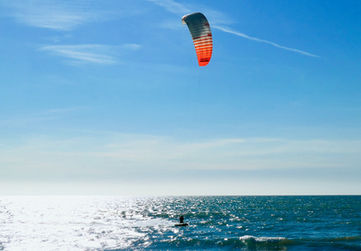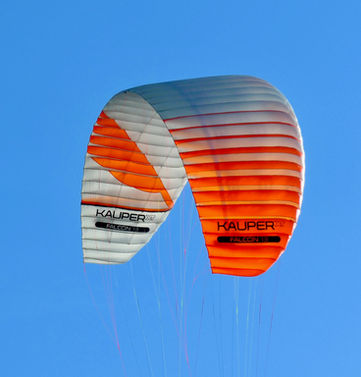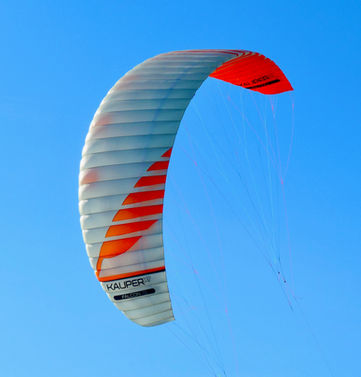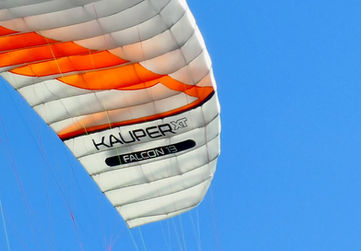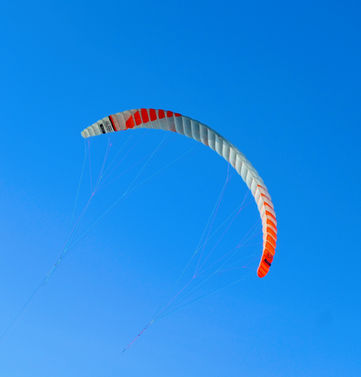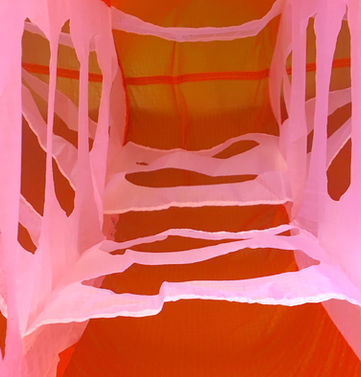


MEIN ULTRALEICHTER FOILKITE V3

GEWICHT & GRÖßEN


Gewichte sind circa Angaben.
ULTRALEICHT - EFFIZIENT - AGIL

Ultraleicht
Beim Falcon wurde alles verwirklicht, was einen Kite NICHT schwer macht. Angefangen bei der Tuchauswahl, unzählige Aussparungen wo immer es nur geht, ohne zugleich die Stabilität zu beeinträchtigen, bis hin zur Auslegung der Waage. Jedes noch so kleine Detail ist für sich separat entwickelt worden. In Summe ergibt nur diese Vorgehensweise einen wirklich ultraleichten Kite. Der Falcon stößt damit in Bereiche vor, die sonst nur Single-Skin-Kites für sich alleine beanspruchen.
Effizient
Von einem Foilkite erwarte ich immer eine gute Leistung. Genauer betrachtet bedeutet das An- und Durchgleiten, Höhelaufen, Hangtime und Depowerverhalten. Beim Falcon werden diese Eigenschaften primär durch sein spezielles Reflex-Profil und durch sein geringes Gewicht erreicht. Die Outline und die Krümmung folgen einerseits der Vorgabe eine gute Leistung zu erzielen, andererseits aber gleichzeitig auch ein sehr einfaches Handling zu haben. Gute Leistung und einfaches Handling sind zusammen die Effizienz, welche mein Foilkite in sich vereinen muss.


Agil
Ein träger Kite hat mir noch nie gefallen. Das war schon bei meinen Tubekites und ist auch bei meinem Foilkite so. Der Falcon ist für einen Foilkite sehr wendig und limitiert mich auf dem Foil in keinster Weise. Er lädt geradezu ein, ständig neue Tricks zu probieren. Seine hohe Fluggeschwindigkeit macht mir richtig viel Spaß und genau darüber kann man in Verbindung mit seiner Wendigkeit extra Leistung aus dem Kite heraus holen. Neu ist beim Falcon-III die deutlich bessere Beschleunigung, was sich sofort bemerkbar macht.
Die Bremse lässt verschiedene Einstellmöglichkeiten zu, so dass der Falcon auf den eigenen Geschmack angepasst werden kann.
FEATURES
"Das primäre Ziel bei der Entwicklung des Falcon-III war einen möglichst unkomplizierten Schirm mit möglichst hoher Leistung und einfachem Handling zu erhalten."
Shape
Der Falcon ist ein Intermediate Foilkite mit mittlerer Streckung von 5,6 beim 13er. Sie ist etwas höher, als bei beiden Vorgängermodellen. Das bedeutet auf der einen Seite eine etwas höhere Leistung, welche jederzeit einfach abzurufen ist. Auf der anderen Seite sorgt die mit 39 recht hohe Zellenanzahl für ein sauberes Profil und wirkt sich ebenfalls positiv auf die Leistung des neuen Falcon aus. Umsteiger von Tube auf Foilkite haben keinerlei Schwierigkeiten, oder gar lange Eingewöhnungsphasen. Dieser Shape mit ausreichend Fläche an den Flügelenden sorgt dafür, dass der Kite sehr agil dreht, aber auch dass die Wingtips stets geöffnet bleiben und keine Klapper entstehen.


Lastaufnahme
Der Falcon wurde von Anfang an ganz anders aufgesetzt, als es sonst bei Foil-Kites üblich ist. Hier übernehmen Ober- und Untersegel keine tragende Funktion mehr, sondern sind nur die Hülle und erzeugen nur noch die aerodynamische Form des Kites. Alle Lasten gehen von den Waageleinen direkt auf die Rippen, die internen Zugbänder und die V-Tapes. Bei der Berechnung der Lasten und der daraus resultierenden Auslegung der Materialien ergaben sich durch diesen Weg völlig neue Möglichkeiten. Diese Entkopplung der Funktionen ermöglicht eine wesentlich leichtere Konstruktion, weil die Lasten nur auf diejenigen Bereiche im Kite konzentriert werden, wo Materialien zum Einsatz kommen, die hohe Lasten dauerhaft aufnehmen können. Der sonst unumgängliche Kompromiss aus Gewicht und Festigkeit entfällt dadurch ganz. Jede einzelne Komponente im Kite kann daher viel präziser und zielgerichteter ausgelegt werden. Allerdings muss auch klar sein, dass eine so gewichtsoptimierte Konstruktion bei Überbelastung zum Bruch führen kann. Eine besondere Aufmerksamkeit des Kiters ist bei Leichtbau-Foilkites ja üblich und obligatorisch. Beim Falcon-III wurden die Zugbänder erstmalig nicht aus Hard-Finish-Tuch gefertigt, sondern aus Gurtband, welches deutlich bessere Festigkeitswerte aufweist.
Depower / Bargefühl
Foilkites wird oft nachgesagt, dass sie erst an den Windfensterrand wandern müssen, um eine Depowerwirkung zu erzeugen. Das ist beim Falcon völlig anders. Der Kite verhält sich einem Tubekite sehr ähnlich. Ein Nachgeben der Bar erzeugt ein sofortiges Nachlassen des Zugs. Erzeugt wird dieses Verhalten durch ein spezielles Reflex-Profil. Gibt man die Bar frei, hängt der gesamte Kite nur noch an den A-Leinen und weht frei aus. Genau diese Eigenschaft wurde nun beim Falcon-III noch mal wesentlich verbessert. Durch dieses Profil und die Aufhängung wird außerdem ein Moment im Kite erzeugt, dass ihn immer wieder aufrichtet, wenn der Anstellwinkel zu klein geworden ist, etwa durch starke Winddreher, oder Böen. Mir war bei der Auslegung des Falcon auch sehr wichtig, ein absolut direktes Bargefühl zu erhalten. Ein schwammiges hin und her an der Bar gibt mir keinen Kontakt zum Kite. Die Halte und Steuerkräfte sind daher sehr nahe an Tubekites.


Relaunch
Foilkites lassen sich bekanntermaßen schon bei extrem wenig Wind über beide Steuerleinen rückwärts starten. Diese Technik funktioniert schon bei etwa 3kn Wind, wenn man es vorher mal geübt hat. Das Besondere beim Falcon ist aber, dass er sich auch über nur eine Steuerleine, ähnlich wie bei Tubekites, relaunchen lässt. Das geht in manchen Situationen viel schneller und einfacher. Der Shape und auch die Aufhängung des Falcon ermöglichen dieses Feature.
Waageleinen/Bridle
Über die Bridle wird bei einem Foil-Kite die gesamte Charakteristik des Kites bestimmt. Aufgrund seines Reflex Profils kommen beim Falcon die höchsten Zugkräfte auf die A-Leinen, etwas weniger auf die B-Leinen usw. Es leuchtet auch ein, dass in der Mitte des Kites höhere Lasten, als am Flügelende auftreten. Die Leinenstärken in der Bridle sollte daher immer entsprechend ausgelegt werden, damit auch dort, wo hohe Lasten aufgenommen werden müssen, auch stärkere Leinen zu finden sind. Die Grafik rechts zeigt am Beispiel der A-Leinen-Ebene, welche Leinen wo zum Einsatz kommen. Man kann gut erkennen, wie viele verschiedene Leinentypen verbaut werden. Es wurden dabei sehr dünne Leinen verwendet, um möglichst wenig Luftwiderstand zu erzeugen. Dennoch haben wir uns sehr bewusst an den Haupt-Trage-Leinen für gemantelte Leinen (Liros PPSLS) entschieden. Damit wird die Längenänderung der Leinen durch den Flugbetrieb erheblich minimiert, weil kein Sand, Salz etc in die Leine eindringen kann und somit auch nahezu keine Verkürzung entsteht. Ein Nachtrimmen ist nur daher sehr selten nötig. Die Topleinen, also die Leinen direkt am Untersegel, sind ungemantelte Leinen (Liros DC). Hier kommen nur sehr wenige Zuglasten auf die jeweilige Leine und diese Leinen haben nur eine geringe Länge, woraus demnach auch nur eine sehr geringe Längenänderung resultieren könnte. Die jeweiligen Leinenebenen sind im Falcon farblich kodiert und erleichtern den Überblick:
A = Rot; B = Gelb; C = Blau; Z = Orange.

DESIGN-TEAM
Der Falcon ist eine gemeinsame Entwicklung von Ernst Strobl und mir. Ernst ist eine wirkliche Größe im Gleitschirmsport. Sportlich erfolgreich als Vize-Weltmeister und seit vielen Jahren Chefkonstrukteur bei U-Turn und diversen anderen Labels, sind seine Fähigkeiten wohl unbestritten. Es hat uns beide nach so vielen Jahren Freundschaft einfach noch mal total gereizt, ein gemeinsames Projekt zu starten. Die ersten Spinnereien begannen bereits im Herbst 2019 und seitdem lässt uns dieser Kite nicht mehr los.


DNA
Der Falcon hatte bei der Entwicklung im Prinzip die gleichen Vorgaben, wie meine Tubekites. Er sollte gut Leistung haben, die aber sehr einfach abzurufen ist. Er muss sich dazu auch schnell mit Luft füllen und beim Relaunch völlig problemlos sein, auch wenn es mal ganz wenig Wind hat und deswegen länger dauert. Dieser Relaunch sollte auch nur durch Zug an einer Steuerleine möglich sein, ähnlich wie beim Tube-Kite. Den Druckaufbau möchte ich bei meinem Foil-Kite natürlich gerne sehr direkt haben, aber er sollte mich nie überfordern, oder gar stressen. Ich möchte mich ja viel lieber aufs Foilen, bzw Kiten generell konzentrieren, anstatt während der Fahrt eingeklappte Flügelenden wieder öffnen zu müssen. Die beiden wichtigsten Punkte waren aber für mich ein extrem geringes Gewicht und eine sehr direkte Depower-Wirkung, wie ich sie sonst nur beim Tube-Kite habe. Eine sehr hohe Agilität war sowieso ein Muss, da mir der Kite ansonsten gar keinen Spaß machen würde. Mit dem Ergebnis sind Ernst und ich mehr als zufrieden.

KONSTRUKTION
"Die Vorgabe einen ultraleichten Foil-Kite zu entwickeln, erledigt man nicht einfach nur durch die Verwendung von sehr leichtem Tuch. Erst die Konstruktionsdetails machen den Unterschied und ergeben einen leichten und trotzdem stabilen Kite"

Materialien
Um einen geschlossenzelligen Foilkite so leicht zu bauen, wie es beim Falcon der Fall ist, führt kein Weg an ultraleichten Tuchmaterialien vorbei. Ernst hat viele Jahre Erfahrung durch seine Gleitschirme in diesem Bereich und deswegen haben wir uns für das ganz neu in 2021 entwickelte Paratex Evolution Material entschieden. Dieses Material ist beidseitig sehr stark mit Silikon beschichtet. Daher nimmt es nahezu gar kein Wasser an, benötigt aber extra geschulte Näher in der Produktion. Das Besondere an dem nur 32 gr/qm leichten Ripstop Tuch ist seine extrem langlebig hohe Luftundurchlässigkeit, welche andere Materialien in den Schatten stellt. Dies garantiert ein hohe Profiltreue auch nach vielen Stunden auf dem Wasser.
Aerodynamik
Foilkites sehen oft aus wie zerknautschte Bettdecken nach langer Nacht. Gerade die Anströmkante dellt oft ein und hat keine Spannung. Aerodynamisch gesehen ist ein solcher Kite sicher nicht optimal. Beim Falcon war uns die Aerodynamik aber mit einer der wichtigsten Punkte. Der Kite sollte am Himmel stehen wie ein Flügel und eine dellenfreie Nasenleiste mit viel Spannung haben. Um dieses Ziel zu erreichen bedarf es viel Erfahrung und Know How im Bereich der Vorspannung bei Gleitschirmen und Foilkites. Wird der Kite zu stark vorgespannt erhält man zwar eine straffe Nasenleiste, aber er neigt auch gerne zum Sackflug/Backstall und ein umgekehrtes Verhalten bei zu wenig Spannung. Das nebenstehende Bild zeigt wie sauber ein Foilkite ausschauen kann, wenn das techn. Design stimmt. Neu beim Falcon-III ist das modifizierte Reflex-Profil, welches den Kite noch mal flinker und agiler macht.


Ballooning
Das Aufblähen der Zellen im Foilkite wird durch den internen Staudruck erzeugt und im Allgemeinen als Ballooning bezeichnet. Das Ziel eines Entwicklers ist, dieses Ballooning möglichst über die gesamte Profillänge und Spannweite zu kontrollieren. Dies geschieht mittels Vorspannung auf Ober- und Untersegel. Harmonieren diese Vorgaben nicht miteinander, entstehen Falten, sowie im schlimmsten Fall aerodynamisch ungünstige Dellen. Sehr aufwendige Schnitte im 3D an den einzelnen Bahnen ergeben einen strömungsgünstigen Verlauf an Nasenleiste und erzeugen einen scharfe Abströmkante. Ganz wichtig ist dabei die Entkopplung von Ober- und Untersegel zu den V-Tapes und Zugbändern. Nur dadurch behält der Kite auch im völlig gedepowerten Zustand sein Ballooning und somit auch seine internen Druckverhältnisse konstant bei.
Interne Verarbeitung
Ein leichter Foilkite ergibt nur dann einen Sinn, wenn die interne Konstruktion ebenfalls sehr leicht, aber dennoch robust ist, um dem Flugbetrieb standzuhalten. Dazu gehören nicht nur sehr exakt ausgeschnittene elliptische Crossports (Löcher) in den Rippen, sondern auch V-Tapes mit einem Saum, um somit deutlich mehr Last aufnehmen zu können. Dieser Saum ist nur 5mm breit und verlangt höchste Präzision von den Nähern. Alle Zugbänder sind nun aus richtigem Gurtband gefertigt und halten den Kite noch besser in Form. Die V-Tapes sind ähnlich wie die Rippen mit ausgeschnittenen Löchern versehen, um weiteres Gewicht einzusparen. Damit die Bremse besonders effektiv wirkt und ein agiles Flugverhalten erzeugt, sind die Crossports in den Rippen so angeordnet, dass sich ein genau definierter Knickpunkt im Profil ergibt.


Verstärkungsprofile
Entlang der Anströmkante sind bei modernen Foilkites sogenannte Verstärkungsprofile eingesetzt. Dies waren bisher immer dünne Kunststoffstäbe, welche für ein stabiles Profil sorgen. Beim neuen Falcon-III sind diese nun aus Nitinol gefertigt. Das gewählte Material der Stäbe ist ein spezielles Metall lässt ein extrem enges Packen des Kites zu und selbst nach Monaten im Kitebag stellen die Stäbe das vorgegebene Profil am Kite korrekt ein. Man kann sogar einen Knoten in die Stäbe machen und sie nehmen nach dem Öffnen des Knotens sofort wieder ihre ursprüngliche Form ein. Die Taschen für die Stäbe auf den Rippen sind sehr aufwendig verarbeitet, so dass auch bei harten Kontakten auf der Nasenleiste keine Beschädigungen am Kite entstehen.
Rippen
Die Rippen im Falcon müssen einen Großteil der Lasten im Kite aufnehmen. Daher werden sie aus Hardfinish-Tuch gefertigt. Dieses Tuch kann wesentlich höhere Lasten aufnehmen, hat aber den Nachteil, dass es viel schwerer ist, als das Paratex für Ober- und Untersegel. Um dennoch einen sehr leichten Kite zu erhalten, werden die Rippen mit elliptischen Crossports (Löcher) versehen, um Gewicht einzusparen. Diese Crossports werden so angeordnet, dass die Statik im Kite nicht vermindert wird. Um weiteres Gewicht einzusparen, werden beim Falcon alle Rippen wo Waageleinen angreifen aus 38 gr Tuch gefertigt. Alle Rippen ohne Waageleinen-Punkte sind nur aus 32 gr Tuch, siehe Linien rechts in Pink. Für die Produktion ein höherer Aufwand, aber ein sehr gutes Mittel, um einen wirklich ultraleichten Kite zu erhalten.


Aufhängung
Das neu entwickelte Paratex Tuch verleiht dem Falcon III noch mehr Agilität und direkteres Fahrgefühl. Um dies direkt auf die Bar zu übertragen, müssen die Anknüpfpunkte der Waageleinen auch diesen Anforderungen angepasst sein. Die neue Konstruktion mit Gurtbändern wird an den Punkten, wo die höchste Last auftreten kann zusätzlich verstärkt, siehe blaue Punkte im Bild links. Dadurch werden die Zugkräfte noch flächiger in die Rippen eingeleitet. Alle anderen Punkte sind gewichtsoptimiert gefertigt.
Entlüftungsventil
Um den Falcon nach dem Kiten möglichst schnell entlüften zu können und trotzdem dafür zu sorgen, dass dies einfach handzuhaben ist, haben wir uns beim Falcon-III nun für nur noch eine einzige Öffnung in der Mitte der Hinterkante entschieden. Die Luftmenge, welche bei geöffnetem Zustand austreten kann ist sehr groß und ermöglicht ein schnelles Packen des Kites. Die Öffnung wird mit einem Klett geschlossen und geöffnet. Eine Röhre aus weißem Spinnackertuch verhindert das eigenständige Verschließen beim Entlüften. Zwei kleine Fähnchen erleichtern das Öffnen des Kletts. Ein weiterer kleiner Klettverschluss sichert die Flugleinen und die Waage beim Packen des Kites


Kite-Trimm
Bei einem Foilkite verändert sich im Laufe des Flugbetriebs der Trimm des Kites durch Veränderung der Längen der Waageleinen. Beim Falcon ist dies schon deutlich minimiert durch den Einsatz von gemantelten Leinen. Sollte dennoch ein Nachtrimmen nötig sein, lässt sich der Mixer getrennt und völlig unabhängig über die B, C und Bremsleinen wieder korrekt einstellen. Weiter kontrollieren kann man den Trimm zusätzlich über die Knoten in den Waggeleinen (langer Mixer-Test).
Kite-Bag
Ein leichter Kite benötigt ein leichtes Kite-Bag. Mit nur 135 gr ist dieses Bag wirklich leicht und eignet sich somit besonders gut für die Reise. Es ist schlicht, funktional und dennoch robust. Keine überflüssigen Details und nur der Blick auf das Wesentliche. Ein Bag so wie ich es mir immer schon gewünscht habe. Die beiden seitlichen Leinen verschließen durch Zug die Öffnung oben am Bag und dienen gleichzeitig als Schulterriemen. Weil der Falcon und das Bag so leicht sind, ist hier keine Polsterung nötig.

TECHN.DATEN

Die Wind Range Tabelle sollte nur als grobe Hilfe für einen Fahrer mit einem Gewicht von 75kg angesehen werden. Bitte wähle die Größe Deines Kites entsprechend Deinem eigenen Körpergewicht, Wasser/Land Einsatz, sowie der Boardgröße und Typ (kleines TT bzw. Foil). Richte Dich dabei nach Deiner eigenen Erfahrung und Deinem verantwortungsvollen Verstand. Alle Gewichte sind ca.-Angaben.
MOMENTE
KEYPOINTS
Farbe

Orange / Hellgrau

Alle Preise inkl. Mehrwertsteuer zzgl. Versandkosten. Alle Gewichte sind circa Angaben.
Entsprechend der ab 01.07.2021 in der EU geltenden Fernverkaufsregelung für grenzüberschreitende Warenlieferungen an Privatpersonen
wird der Mehrwertsteuersatz des Ziellands berechnet.


